通过病房模拟学生对电子病历的信心和知识的评估研究
IF 2.5
3区 医学
Q1 NURSING
引用次数: 0
摘要
注册护士需要具备数字健康素养才能使用患者的电子病历。为注册护士学生提供病房模拟培训,有可能提高他们对电子医疗记录的参与度。然而,探索这种方法的证据很少。方法30名三年级护生在10周的时间内完成7个病房模拟。数据收集于干预前、干预中和干预后。在干预时间框架(Friedman’s)和个体时间点(Wilcoxon)之间分析调查项目得分的差异。结果干预前后学生的电子病历知识(p = 0.024)和电子病历知识(p = 0.004)均有显著提高。干预前后,学生对患者电子观察图(p = 0.033)和电子病历(p = 0.002)记录的信心显著提高。在干预前和干预后的时间点之间,与患者电子病历记录相关的焦虑水平显著降低(p = 0.005)。结论病房模拟在改善与电子病历使用相关的学生相关结果方面显示出希望和有效。未来的研究需要确定这种干预措施的有效性。本文章由计算机程序翻译,如有差异,请以英文原文为准。
Student confidence and knowledge with electronic medical records through on-ward simulation: An evaluation study
Background
Registered nurses require digital health literacy to use patient electronic medical records. Incorporating on-ward simulation training for student Registered Nurses has the potential to improve engagement with electronic medical records. However, there is minimal evidence exploring this approach.
Method
Third-year nursing students (n = 30) completed seven on-ward simulations across 10 weeks of professional experience placement. Data were collected pre-intervention, mid-intervention and post-intervention. Differences in survey item scoring were analyzed across the intervention timeframe (Friedman’s) and between individual timepoints (Wilcoxon).
Results
A significant improvement in student knowledge documenting electronic observation charts (p = 0.024) and electronic medical records (p = 0.004) was observed between pre-and post-intervention timepoints. Student confidence in documenting in the patient’s electronic observation charts (p = 0.033) and electronic medical records (p = 0.002) was significantly improved pre- and post-intervention. Anxiety levels associated with documenting in the patient electronic medical records were significantly reduced between pre-and post-intervention timepoints (p = 0.005).
Conclusion
On-ward simulations show promise and appears to be efficacious in improving student-related outcomes associated with electronic medical record use. Future research is required to determine the effectiveness of this intervention.
求助全文
通过发布文献求助,成功后即可免费获取论文全文。
去求助
来源期刊

Clinical Simulation in Nursing
NURSING-
CiteScore
5.50
自引率
15.40%
发文量
107
期刊介绍:
Clinical Simulation in Nursing is an international, peer reviewed journal published online monthly. Clinical Simulation in Nursing is the official journal of the International Nursing Association for Clinical Simulation & Learning (INACSL) and reflects its mission to advance the science of healthcare simulation.
We will review and accept articles from other health provider disciplines, if they are determined to be of interest to our readership. The journal accepts manuscripts meeting one or more of the following criteria:
Research articles and literature reviews (e.g. systematic, scoping, umbrella, integrative, etc.) about simulation
Innovative teaching/learning strategies using simulation
Articles updating guidelines, regulations, and legislative policies that impact simulation
Leadership for simulation
Simulation operations
Clinical and academic uses of simulation.
 求助内容:
求助内容: 应助结果提醒方式:
应助结果提醒方式:


